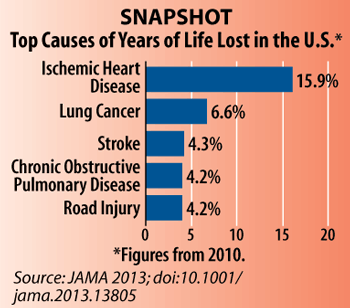U.S. Health Status Falls Internationally
Population health in the U.S. improved between 1990 and 2010, but it did not keep pace with other wealthy nations, deteriorating in this 20-year period on nearly every major health measure. While U.S. life expectancy and healthy life expectancy increased, the U.S. rank for age-standardized death rate, years of life lost due to premature mortality, life expectancy, and healthy life expectancy all fell in comparison to 34 other Organization for Economic Cooperation and Development countries. Among these measures, the U.S. ranked no better than 26th.
"The State of U.S. Health, 1990–2010: Burden of Diseases, Injuries, and Risk Factors" looked at the overall burden on health systems from a range of fatal and non-fatal health factors, including estimates for death and disability from 291 diseases, conditions and injuries, along with 67 risk factors. These findings are part of the Global Burden of Disease 2010, an international collaborative effort to synthesize epidemiology data and compare health measures over time and across diseases and countries.

Disabling rather than fatal diseases now account for most of the disease burden in the U.S. The toll from ischemic heart disease, lung cancer, lower respiratory infections, HIV/AIDS, and preterm birth complications fell between 1990–2010, while the impact of depression, low back and neck pain, and diabetes rose.
The U.S. ranked in the bottom third of age-standardized years of life lost rates in 16 of 25 diseases or conditions. The researchers attributed much of the U.S.’s poor standing in comparison to other countries to poor diet and inadequate physical activity. The top five risk factors as a percentage of disability-adjusted life-years included dietary risks, tobacco smoking, high body mass index, high blood pressure, and high fasting plasma glucose.
Within the overall trend of the growing burden of chronic diseases, the researchers found increases in diabetes and chronic kidney disease particularly noteworthy. Effective management of these increasingly prevalent diseases likely will require greater expenditures in the coming years.